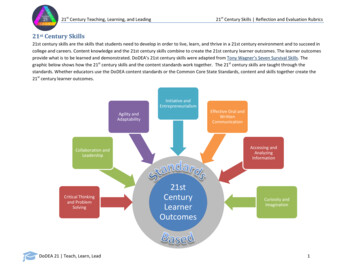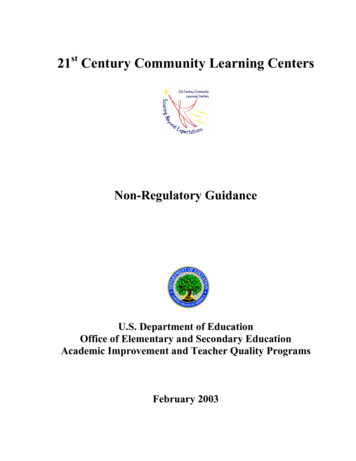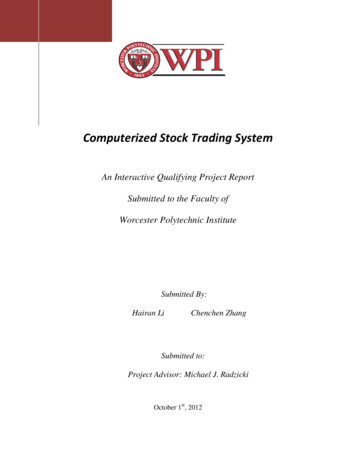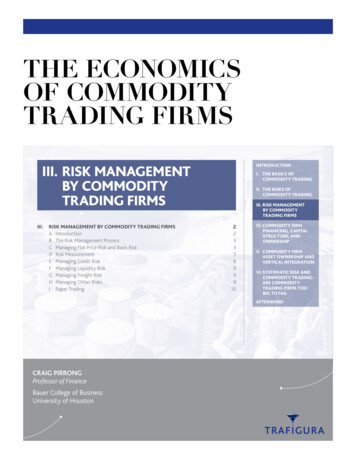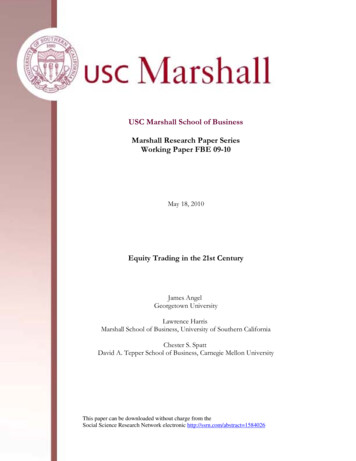
Transcription
USC Marshall School of BusinessMarshall Research Paper SeriesWorking Paper FBE 09-10May 18, 2010Equity Trading in the 21st CenturyJames AngelGeorgetown UniversityLawrence HarrisMarshall School of Business, University of Southern CaliforniaChester S. SpattDavid A. Tepper School of Business, Carnegie Mellon UniversityThis paper can be downloaded without charge from theSocial Science Research Network electronic http://ssrn.com/abstract 15840261
Equity Trading in the 21st CenturyFebruary 23, 2010James J. AngelAssociate ProfessorMcDonough School of BusinessGeorgetown UniversityLawrence E. HarrisFred V. Keenan Chair in FinanceProfessor of Finance and Business EconomicsMarshall School of BusinessUniversity of Southern CaliforniaChester S. SpattPamela R. and Kenneth B. Dunn Professor of FinanceDirector, Center for Financial MarketsTepper School of BusinessCarnegie Mellon UniversityElectronic copy available at: http://ssrn.com/abstract 1584026
1. Introduction 1Trading in financial markets changed substantially with the growth of new informationprocessing and communications technologies over the last 25 years. Electronic technologiesprofoundly altered how exchanges, brokers, and dealers arrange most trades. In some cases,innovative trading systems are so different from traditional ones that many political leaders andregulators do not fully appreciate how they work and the many benefits that they offer toinvestors and to the economy as a whole.In the face of incomplete knowledge about this evolving environment, some policymakers nowquestion whether these innovations are in the public interest. Technical jargon such as “darkliquidity pools,” “hidden orders,” “flickering quotes,” and “flash orders” appear ominous to thosenot familiar with the objects being described. While professional traders measure systemperformance in milliseconds, others wonder what possible difference seconds—much lessmilliseconds—could have on capital formation within our economy. The ubiquitous role ofcomputers in trading systems makes many people nervous, and especially those who rememberthe 1987 Stock Market Crash and how the failure of exchange trading systems exacerbatedproblems caused by traders following computer-generated trading strategies. Strikingly, themechanics of the equity markets functioned very well during the financial crisis, despite thewidespread use of computerized trading. Indeed, much of the focus of computerized tradingduring the financial crisis has been on offering liquidity (“market-making”) and shifting liquidity(“arbitrage”) rather than as in 1987 in consuming the market’s liquidity (“portfolio insurance”).This paper discusses recent innovations in trading systems and their effects on the markets.Using non-technical language, we show that investor demands for better solutions to the tradingproblems that they have traditionally faced —and will always face—largely drove theinnovations. The introduction of computerized trading systems and high-speed communicationsnetworks allowed exchanges, brokers, and dealers to better serve and attract clients. With theseinnovations, transaction costs dropped substantially over the years, and the market structurechanged dramatically.The winners first and foremost have been the investors who now obtain better service at a lowercost from financial intermediaries than previously. Secondary winners have been the exchanges,brokers, and dealers who embraced electronic trading technologies and whose skills allowed themto profitably implement them. The big losers have been those intermediaries who did notinnovate as successfully, and, as a consequence, became less competitive, and ultimately lessrelevant.Not all developments in financial market trading have been in the public interest. We identifyseveral problems that regulators should consider addressing to ensure that our markets continue toserve well both investors and the corporations that use them for raising capital. For example,systemic risks can arise because poorly capitalized broker-dealers allow electronic traders to1To better inform parties interested in understanding innovations in market structures, Knight Capital Group, Inc.commissioned the authors to write a paper describing new market structures and the resulting effects on the markets.This article presents our analyses and opinions only and does not necessarily represent the opinions of the sponsor ofthis project. The authors retained full editorial control over the content and conclusions of this report.2Electronic copy available at: http://ssrn.com/abstract 1584026
access the market in their name with insufficient real-time risk management controls on theirtrading. While exchanges and clearinghouses can alleviate this problem by better regulating theirmembers, we support the recent SEC rule proposal on this issue. Front-running across marketsalso concerns us. To some extent, well-informed traders or their agents can control this problemthrough careful transaction cost analyses, but the SEC and CFTC should write and enforce newregulations that prevent agents from front-running client orders in correlated instruments.Finally, transparency and fairness problems arise when trading systems employing make-or-takepricing schemes compete against exchanges that charge traditional transaction fees and againstdealers who cannot charge access fees. The SEC could solve this problem with a simplemodification to Regulation NMS.While the markets could potentially benefit from some specific regulatory changes, regulatorsmust be sensitive to the “unintended consequences” of poorly considered responses to concernsnow being raised about recent changes in the trading environment, many of which are notuniversally understood. Technological innovations have led to the emergence of electronicliquidity suppliers who have outcompeted— and thus supplanted—most traditional dealers bylowering the costs of trading to investors. If poorly conceived regulations were to handicapelectronic liquidity providers, a significant degradation in market quality would be the likelyunintended consequence.An executive summary of our report appears in the next section. The following section providesempirical evidence of how markets have changed in recent years, and in particular, how they havebecome more liquid over time. We then discuss the main trading problems that traders mustsolve and how traders traditionally solved those problems. We next discuss several of theinnovative systems that exchanges, brokers, and dealers have created to help investors addressthese problems, and we explain how they benefit the economy. We then offer brief commentsabout the market’s performance during the financial crisis and contrast the equity markets withother market structures. We conclude by discussing concerns about specific aspects of electronictrading.3
2. Executive SummaryThe U.S. equity market changed dramatically in recent years. Automation gradually transformedthe market from a human-intermediated market to a computer-intermediated market with littlehuman interaction or real-time oversight. Regulation also changed. The 1997 order-handlingrules and the 2001 decimalization led to dramatic reduction in transactions costs. RegulationNMS cleared regulatory impediments to electronic trading and thereby led to increasedcompetition between market centers. Dozens of new trading platforms emerged, including somewith very different models from the old exchanges. This study examines the impact of thesechanges on market quality. Our major findings follow.2.1 Trading problems remain unchanged Traders still face the same challenges as before: Minimize total trading costs includingcommissions, bid/ask spreads, and market impact. Large traders remain very careful about exposing their trading interest. New technologies allow traders to implement traditional strategies more effectively.Traders today face the same challenges they have always faced. All traders seek to minimizetheir transactions costs, which include commissions, bid-ask spreads, and market impact. Buyersand sellers must find each other and agree upon a price. They must avoid trading with betterinformed traders to avoid losses from being on the wrong side of a transaction.Large institutional traders cannot widely publicize their interest in trading large blocks.Indiscriminant dissemination of such information increases the costs of their trades by scaringaway counterparties, by attracting front-runners and other traders who can trade to profit fromthis information at the expense of the large traders.Traders used to solve these problems on exchange floors. New communications and computingtechnologies now allow them to solve these problems in electronic trading systems atsubstantially lower cost.For example, large traders once used floor brokers to hide the full sizes of their orders. Thebrokers displayed size only to traders that they trusted would not unfairly exploit the information.Now large traders use the hidden order facilities of electronic exchanges and dark pools to controlthe exposure of their orders. These facilities generally are more reliable than floor brokers andmuch less costly to use. The traditional NYSE floor was the forerunner of today’s electronic“dark pools” that only disseminate information to trusted traders.2.2 The market changed Liquidity increased as volumes grew substantially. Average trade size fall as electronic systems allowed traders to easily divide orders to obtainbetter executions. Quote traffic increased substantially. Competition among exchanges intensified.4
We document many changes that have occurred in recent years. U.S. average daily reportedtrading volume increased dramatically in recent years, from about 3 billion shares per day in 2003to nearly 10 billion shares per day in 2009. Over this period, the share of trading reported bytraditional exchanges fell substantially. The market share of the NYSE in its listed stocks fellfrom 80% of all volume in January 2003 to 25.8% in December 2009.The nature of trading changed as “high frequency” and “algorithmic” trading grew to dominatetrading volumes. Average trade size fell substantially as computers made slicing large blocksinto small pieces a cost effective means of limiting adverse costs of trading large positions.Automated traders began providing liquidity, supplementing and displacing traditional liquiditysuppliers. The number of quote updates per trade, as well as the number of orders cancelled perexecuted trade, increased dramatically as traders employed new electronic strategies for offeringand searching for liquidity.2.3 Market quality improved dramaticallyExecution speeds fell.Bid-ask spreads fell and remain low.Commissions fell.Market depth increased.Volatility continues to fluctuate.These changes substantially improved market quality. Virtually every dimension of U.S. equitymarket quality is now better than ever. Execution speeds have fallen, which greatly facilitatesmonitoring execution quality by retail investors. Retail commissions have fallen substantiallyand continue to fall. Bid-ask spreads have fallen substantially and remain low, although theyspiked upward during the financial crisis as volatility increased. Market depth has marchedsteadily upward. Studies of institutional transactions costs continue to find U.S. costs among thelowest in the world.Volatility spiked in 2008 during the financial crisis. However, unlike during the Crash of 1987,the U.S. equity market mechanism handled the increase in trading volume and volatility withoutdisruption. However, the selling ban increased trading costs by frustrating the implementation ofliquidity providing and shifting strategies by active traders who often must sell short to offerliquidity or manage the risks of their trading.The quality of the U.S. equity market is especially notable in comparison to markets in otherinstruments and countries. For example, U.S. retail customers pay much higher transactions costswhen trading U.S. Treasuries in comparison to fixed income ETFs that contain the sameTreasuries.5
2.4 Some improvements can be made “Make or take” pricing causes problems. Direct access requires appropriate risk management supervision. Front running orders in correlated securities should be banned.Electronic trading raises some concerns that should be addressed. In particular, the “make ortake” model for pricing exchange services has led to perverse outcomes. In the make or takemodel, trading platforms charge access fees to traders who “take” liquidity with marketableorders and pay rebates to limit order traders that “make” liquidity by placing standing limitorders. Current best execution standards require brokers to take the “best” price without regard tothe access fees. We recommend that the SEC require that all brokers pass through the fees andliquidity rebates to their clients. The SEC also should indicate clearly that the principles of bestexecution apply to net prices and not to quoted prices. Alternatively, the SEC simply could banaccess fees.Concerns over the risk management practices of brokerage firms that provide “naked access” arelegitimate. We support the proposed SEC rules that would require such firms to have appropriaterisk management policies in place to prevent a catastrophic trading meltdown. At the same time,however, we note that no market-wide risk management systems are in place that would deal witha computer-generated meltdown in real-time. Regulators should give careful consideration to thequestion of what real-time controls could prevent a major computer malfunction from instantlythrowing the market into chaos.Although front-running a customer’s order in the same instrument is illegal, we are concernedabout front running in correlated instruments. For example, buying S&P 500 futures contractswhile holding a large open customer buy order in an S&P 500 ETF (to profit from the expectedprice impact of the customer order) should be illegal since arbitrageurs will quickly shift the priceimpact of the broker’s order in the futures market to the ETF market where it will increase thecost of filling the customer’s order.6
3. An Empirical Profile of Recent Changes in MarketsInnovations in electronic trading have produced new trading platforms and order types. Marketparticipants now use better and faster tools, and the markets changed as a result. This sectioncharacterizes how various measures of market activity and liquidity changed in recent years.3.1Trading volumes increasedSource: Barclays Capital Equity ResearchReported equity trading volumes tripled in the last nine years. Several factors produced thisoutcome. The direct costs of trading fell substantially, making it economically feasible toimplement strategies that would have been uneconomic at higher costs. The increase inderivative products also increased the amount of trading as arbitrage activity keeps derivativesprices linked with prices in the underlying cash markets. The growth in the number of exchangetraded funds (ETFs) also contributed to the increase in trading volume.7
3.23.2.1Bid-ask spreads fell and remain smallNYSE bid-ask spreads since 1993Source: Chordia, Tarun, Richard Roll and Avanidhar Subrahmanyam, 2008, Liquidity and Market Efficiency, Journalof Financial Economics 87:2, 256, as published.This chart tracks the fall in quoted bid-ask spreads on the NYSE following the reduction of theminimum price variation (tick size) from one-eighth to one-sixteenth and then to one cent.8
3.2.2NASDAQ bid-ask spreads since 1993Source: Hasbrouck, Joel, 2009, Trading Costs and Returns for U.S. Equities: Estimating Effective Costs from DailyData, Journal of Finance 64:3, 1457, as publishedDecimalization, along with the SEC’s order handling rules, led to a large decline in bid-askspreads on NASDAQ as well as the NYSE.9
3.2.3Quoted and effective NYSE and NASDAQ bid-ask spreads since 2003Source: Knight Capital GroupThis chart displays the median quoted bid-ask spreads for NYSE- and NASDAQ-listed stocks.Source: Public Rule 605 Reports from Thomson, Market orders 100-9999 sharesThis chart displays the average effective bid-ask spreads obtained from the Rule 605 reports foreligible market orders. The effective bid-ask spread estimates spreads that investors actually pay.It is twice the difference between the actual trade price and the midpoint of the quoted NBBO atthe time of order receipt. Once again, we see that the general trend on spreads has beendownward, interrupted by an upward spike during the recent turbulence.10
3.2.4Quoted bid-ask spreads for index stocks since 2003Source: Knight Capital GroupThis chart presents the median bid-ask spread for S&P 500 stocks. The spread on many highvolume stocks is now often only a penny or two.11
Source: Knight Capital GroupThis chart shows the median quoted bid-ask spreads for the Russell 2000 Index. The downwardtrend in spreads, which is so visible for the larger stocks, has not been as uniform for smallerstocks.12
3.2.5Quoted Russell 2000 bid-ask spreads relative to VIX since 2003Source: Knight Capital GroupMost spreads spiked up during the financial crisis because high volatility increases risks formarket makers. Dividing the reported spread by the VIX index of volatility shows that liquidityadjusted for volatility has been dropping. VIX measures the implied volatility of S&P500 optionstraded on the CBOE.13
3.3Market depth increased since 2003Source: Knight Capital GroupMarket depth is an indicator of liquidity. This chart shows the median number of shares (both bidand offer) displayed at the NBBO in the exchanges and ECNs. We see a steady upward trendover the last several years, an indicator of increased liquidity. Deeper markets imply lower priceimpacts for investors.14
3.3.1Displayed depth behind the NBBO since 2003Source: Knight Capital GroupDepth increased substantially not just at the NBBO but also behind it. This chart shows the depthof book for various groups of stocks such as the S&P 500 and the Russell 2000 at the NBBO aswell as within six cents of the NBBO.15
3.4Market volatility fluctuatedSource: Knight Capital GroupVolatility has always fluctuated in the U.S. equity markets, reflecting the changing levels ofuncertainty in the overall economy. The 1930s and the early 1970s were periods of highvolatility. Volatility also increased during the recent financial crisis. The VIX index, which isbased on the implied volatility of S&P 500 options, was unusually low in 2006 but rose to recordlevels in the fall of 2008. It has since fallen to more normal levels. Volatility for the market as awhole is a poor measure for characterizing the impact of changes in market technology on thetrading of individual stocks. We thus need to correct for overall market volatility.16
Source: Knight Capital GroupOne simple way to correct for overall market volatility is to look that the total volatility ofindividual stocks relative to the VIX. This chart displays the average actual monthly intradayvolatility of various groups of the stocks divided by the VIX. This measure has fluctuated inmuch the same range in recent years, indicating no overall increase in the volatility in excess ofthe VIX.17
3.5Retail commissions fell and remain lowSource: Barclays Capital Equity ResearchWith small bid-ask spreads, commissions remain a significant component of total transactionscosts paid by retail investors. This chart shows the average commissions charged by three of thelargest online brokerage firms. Price competition intensified recently with prices dropping evenfurther in last few months.18
Source: AAII Journal, Discount Broker Guide, February 2007 at http://www.aaii.com/journal/200702/guide.pdf, aspublished.This chart from the American Association of Individual Investors documents the steep drop incommissions among all the firms in its sample over the 27 years ending in 2007.19
3.6Average trade size fellSource: NYSE-Euronext, nyx.comThe average size of reported trades has fallen significantly in the last decade. Average trade sizeon the NYSE by the end of 2009 was approximately 300 shares, half of what it was five yearsearlier. Traders have always chopped large orders into smaller ones to minimize market impact.Automation and lower trading costs now allow traders to economically slice orders into evensmaller slices through what is known as “algorithmic” trading.20
3.7Quote frequency increasedSource: Knight Capital GroupThis chart displays the average number of quote updates per minute for various groups of stocks.The frequency of quote updates increased dramatically in recent years, with a spike during theperiod of intense volatility and volume associated with the recent financial crisis. The increasingfrequency of quote updates is consistent with higher trading volumes and the increased use ofalgorithmic trading strategies that break large orders into many smaller ones.21
3.8Execution times fellSource: Rule 605 data from Thomson for all eligible market orders (100-9999 shares)Increasing automation led to a market wide decrease in the speed of execution for small marketorders.22
3.9Order cancellations relative to executions increasedSource: NASDAQ ITCH data provided by Knight Capital GroupThe ratio of orders cancelled to orders executed more than tripled in recent years, from under 10at the beginning of 2002 to over 30 by the end of 2009. This graph presents the ratio of ordercancellations per execution from NASDAQ ITCH data. Many trading strategies require thecancellation of an order. For example, an electronic market maker who wants to update a quotewill first cancel the previous quote in the system. As trading volume increases and average tradesize decreases, one expects many more quote updates.23
3.10 Market shares at traditional markets fellSource: Barclays Capital Equity ResearchRegulation NMS (2005) freed electronic trading platforms to compete with the NYSE.Subsequently, new entrants gained significant market share. The NYSE market share of volumein its listed stocks fell from 80% at the beginning of 2003 to 25% by the end of 2009. NASDAQmatched share volume also increased, but it later fell as volume traded through new entrants suchas BATS and DirectEdge increased. The “other” category, which includes both internalization bydealers as well as “dark pool” trading systems, also increased.24
Source: Barclays Capital Equity ResearchNASDAQ market share fell in recent years as other competitors gained ground. The oldNASDAQ did not actually match trades, but relied on a dealer network for order execution.NASDAQ later added its own matching engine, SuperMontage, and acquired ECNs such asINET.25
3.11U.S. transactions costs are among the lowest in the worldSource: Investment Technology Group, Inc., ITG Global Trading Cost Review 2ITG, Inc. regularly reviews institutional trading costs around the world. The above chart showsthat trading costs in the U.S. are among the lowest in the world. Care must be taken in using theirdata, as ITG does not correct for differences in the sizes of companies in different markets.2http://www.itg.com/news events/papers/ITG GlobalTradingCostReview 2009Q3.pdf26
4. Classical Trading Problems and Their Traditional SolutionsThree problems complicate trading. First, and most obviously, buyers must find sellers andsellers must find buyers. Second, traders are anxious not to trade with informed traders to avoidthe losses typically associated with such trades. Finally, traders seeking to execute large ordersmust address several problems to ensure that they obtain the best prices for their trades. Thissection describes these problems and discusses the market structures that traders traditionallyused to solve them. The following section discusses how recent advances in electroniccommunications and information processing technologies have substantially changed tradingpractices, and in particular, have provided innovative solutions to these problems.4.1 The search for liquidityTrades result only when willing buyers and sellers can meet and negotiate terms. Traditionally,traders came to exchanges where they or their brokers could locate one another and arrangetrades. By providing a common meeting place and time, exchanges greatly decreased the cost ofsearching for liquidity.Arranging trades at exchanges works well when buyers and sellers are both present. However,when securities are infrequently traded, or when traders seek to trade much more size than istypically available at an exchange, trading often moves away from traditional exchanges.Finding a buyer or a seller in an infrequently traded security is often quite difficult. In suchsecurities, investors will often trade with dealers. Dealers have an advantage in these markets assuppliers of liquidity because they often are more patient searchers than their clients. They alsomay have an advantage if traders widely recognize that they specialize in trading such securities,so that traders approach them when they want to trade. Since dealers generally are easy to find,they can conduct their businesses away from exchanges.When traders seek to trade much more size than is typically available at an exchange, finding awilling counterparty often is particularly difficult. If the desired trade size is not too large, ablock dealer might facilitate the transaction. But dealers often are not willing or able to arrangevery large trades. To arrange such trades, traders seek the services of a block broker.Block brokers specialize in knowing who would want to trade if presented with a suitableopportunity. Often such traders are not even aware of their interest since many traders whoultimately are willing to trade do not consider whether they would trade until asked. Economistscall such traders latent liquidity suppliers. Block brokers identify such traders by keeping track ofwho owns large blocks of securities that they might sell and of who might be interested inpurchasing large blocks of securities. Of course, the information that they collect andcommunicate rarely appears on exchange floors or in exchange trading systems. Manyinvestment banks run large off-exchange block brokerage operations, as do some firms that havespecialized in block brokerage, such as Jones Trading, whose operations were the original “darkpools.”Some information providers such as Autex offer systems that allow traders to post indications ofinterest (IOI) designed to help other large traders find them. An IOI is a message that effectively27
says, “I’m interested in buying XYZ—give me a call.” These messages are similar to those thatappear on Craigslist in the sense that they help direct people to potential matches. Like those onCraigslist, they also can be potentially dangerous. Many brokers post IOIs with the hope ofobtaining clients, many traders call upon IOIs with the hope of identifying trading interest thatthey can exploit, and many traders can post false IOIs with the hope of influencing the markets.These problems ensure that the flow of IOIs may not be particularly informative.4.2 Informed tradingAll traders would prefer to avoid trading with well-informed traders, who have superiorinformation about future price levels. They buy when they expect prices to rise and sell whenthey expect prices to decline. Since well-informed traders are correct more often than not, theytend to profit. Those traders who trade against them tend to lose when they buy, or lose theopportunity to profit if they sell. Either way, they often will regret that they had traded.Accordingly, traders try to avoid trading with well-informed traders or on the side opposite fromwhich well-informed traders are trading.Concerns about informed trading make trading large blocks difficult. Most traders presume thatlarge traders are well informed because well-informed traders tend to trade large orders andbecause large traders generally can afford the research necessary to become well informed.Indeed, empirical findings show that large trades tend to reflect more information than smalltrades. The risk of trading with a well-informed trader makes dealers and other traders wary offilling the orders of large traders. Large traders thus must convince other traders that they are notwell informed to fill their orders at the best possible prices.Dealers who know their clients well generally know who are well informed and who trade forother reasons. The dealers tend to provide better prices to those traders whom they believe tradefor other reasons and try to avoid trading much, if at all, with well-informed traders.When dealers do not know whether they are trading with informed traders, for example whenthey trade with anonymous traders, they widen their spreads to recover from uninformed traderswhat they lose on average to well-informed traders. Since traders transact anonymously atexchanges, exchange bid-ask spreads depend on the degree to which informed traders participatein the exchange markets.Brokers who know their clients well also can help them obtain better prices by telling potentialcounterparties that their clients are trading for reasons other than information. They stake theirreputations on the quality of this representation. If other traders suspect that the brokers havebeen disingenuous, they will avoid trading with them in the future.Although exchange floor brokers generally cannot tell other traders that their clients are wellinformed, they can tell them they are not well informed. Those who honestly represent the natureof their clients’ motives can obtain better prices for their uninformed clients.Many dealers specialize in filling retail orders. Since retail traders are not as informed on averageas are institutional traders, dealers can offer better prices to them. To capture the benefitsassoc
USC Marshall School of Business . Marshall Research Paper Series . Working Paper FBE 09-10 . May 18, 2010 . Equity Trading in the 21st Century . James Angel . Georgetown University . Lawrence Harris Marshall School of Business, University of Southern California Chester S. Spatt David A. Tepper School of Business, Carnegie Mellon University


